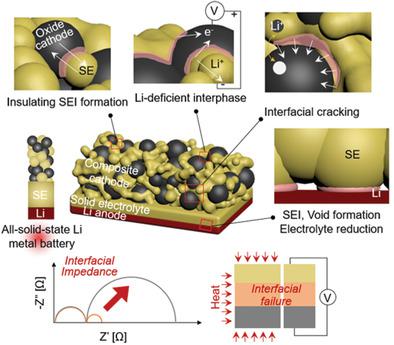当前位置:
X-MOL 学术
›
Adv. Energy Mater.
›
论文详情
Our official English website, www.x-mol.net, welcomes your
feedback! (Note: you will need to create a separate account there.)
Solid‐State Li–Metal Batteries: Challenges and Horizons of Oxide and Sulfide Solid Electrolytes and Their Interfaces
Advanced Energy Materials ( IF 24.4 ) Pub Date : 2020-11-09 , DOI: 10.1002/aenm.202002689 Kun Joong Kim 1 , Moran Balaish 1 , Masaki Wadaguchi 2 , Lingping Kong 1 , Jennifer L. M. Rupp 1, 3
Advanced Energy Materials ( IF 24.4 ) Pub Date : 2020-11-09 , DOI: 10.1002/aenm.202002689 Kun Joong Kim 1 , Moran Balaish 1 , Masaki Wadaguchi 2 , Lingping Kong 1 , Jennifer L. M. Rupp 1, 3
Affiliation

|
The introduction of new, safe, and reliable solid‐electrolyte chemistries and technologies can potentially overcome the challenges facing their liquid counterparts while widening the breadth of possible applications. Through tech‐historic evolution and rationally analyzing the transition from liquid‐based Li‐ion batteries (LIBs) to all‐solid‐state Li‐metal batteries (ASSLBs), a roadmap for the development of a successful oxide and sulfide‐based ASSLB focusing on interfacial challenges is introduced, while accounting for five parameters: energy density, power density, longterm stability, processing, and safety. First taking a strategic approach, this review dismantles the ASSLB into its three major components and discusses the most promising solid electrolytes and their most advantageous pairing options with oxide cathode materials and the Li metal anode. A thorough analysis of the chemical, electrochemical, and mechanical properties of the two most promising and investigated classes of inorganic solid electrolytes, namely oxides and sulfides, is presented. Next, the overriding challenges associated with the pairing of the solid electrolyte with oxide‐based cathodes and a Li‐metal anode, leading to limited performance for solid‐state batteries are extensively addressed and possible strategies to mitigate these issues are presented. Finally, future perspectives, guidelines, and selective interface engineering strategies toward the resolution of these challenges are analyzed and discussed.
中文翻译:

固态锂金属电池:氧化物和硫化物固体电解质及其界面的挑战和前景
引入新的,安全可靠的固体电解质化学和技术可以潜在地克服其液体同类产品所面临的挑战,同时扩大可能的应用范围。通过技术历史演进并合理地分析从液态锂离子电池(LIB)到全固态锂金属电池(ASSLB)的过渡,成功开发了以氧化物和硫化物为基础的ASSLB的路线图介绍了界面挑战,同时考虑了五个参数:能量密度,功率密度,长期稳定性,加工和安全性。首先采取战略方针 这篇评论将ASSLB分解为三个主要组成部分,并讨论了最有希望的固体电解质及其与氧化物阴极材料和锂金属阳极的最有利配对选项。介绍了对两种最有前途和研究最多的无机固体电解质,即氧化物和硫化物的化学,电化学和机械性能的全面分析。接下来,广泛解决了与固体电解质与基于氧化物的阴极和锂金属阳极配对相关的最严峻的挑战,这导致固态电池的性能受到限制,并提出了缓解这些问题的可行策略。最后,对解决这些挑战的未来观点,指南和选择性接口工程策略进行了分析和讨论。
更新日期:2021-01-07
中文翻译:

固态锂金属电池:氧化物和硫化物固体电解质及其界面的挑战和前景
引入新的,安全可靠的固体电解质化学和技术可以潜在地克服其液体同类产品所面临的挑战,同时扩大可能的应用范围。通过技术历史演进并合理地分析从液态锂离子电池(LIB)到全固态锂金属电池(ASSLB)的过渡,成功开发了以氧化物和硫化物为基础的ASSLB的路线图介绍了界面挑战,同时考虑了五个参数:能量密度,功率密度,长期稳定性,加工和安全性。首先采取战略方针 这篇评论将ASSLB分解为三个主要组成部分,并讨论了最有希望的固体电解质及其与氧化物阴极材料和锂金属阳极的最有利配对选项。介绍了对两种最有前途和研究最多的无机固体电解质,即氧化物和硫化物的化学,电化学和机械性能的全面分析。接下来,广泛解决了与固体电解质与基于氧化物的阴极和锂金属阳极配对相关的最严峻的挑战,这导致固态电池的性能受到限制,并提出了缓解这些问题的可行策略。最后,对解决这些挑战的未来观点,指南和选择性接口工程策略进行了分析和讨论。















































 京公网安备 11010802027423号
京公网安备 11010802027423号